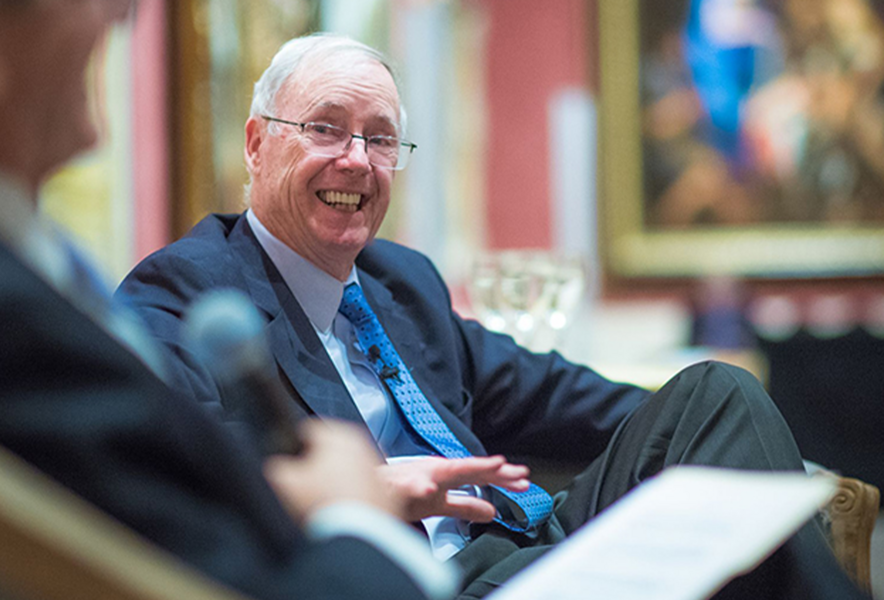Christopher T. Walsh, a highly influential professor of chemical biology who was a former MIT faculty member and Department of Chemistry head, died on Jan. 10 at the age of 79.
At the time of his death, Walsh was the Hamilton Kuhn Professor of Biological Chemistry and Molecular Pharmacology, Emeritus, at Harvard Medical School, but he began his career in 1972 as a jointly appointed faculty member in the MIT departments of Chemistry and Biology. Walsh would go on to spend 15 years at MIT, and served as head of the Department of Chemistry from 1982 to 1987.
“Chris T. Walsh was a titan of chemical biology, who made groundbreaking contributions to antibiotic resistance, enzyme reaction mechanisms, and the biosynthesis of natural products,” says Professor Troy Van Voorhis, the current head of the MIT Department of Chemistry. “He was a leader at MIT during his years on the faculty here, and a treasured member of the chemistry community in the Greater Boston area. He will be sorely missed.”
A native of Boston, Walsh’s academic career began at the Roxbury Latin School, leading him to earn his undergraduate degree from Harvard University and his PhD from The Rockefeller University. He completed postdoctoral research at Brandeis University before beginning his independent research, focused on enzymes and enzyme inhibitors, with specialization in antibiotics and the biosynthesis of other biologically and medicinally active natural products, at MIT as a jointly appointed faculty member in the departments of Chemistry and Biology.
Professor of chemistry and biology Catherine Drennan would need “a book’s worth of space” to adequately describe what Walsh meant to her as a collaborator, mentor, and friend. “We had so many great conversations about science, often in front of a graphics computer looking at a new crystal structure with our students gathered around us,” recalls Drennan. “And, beyond the professional guidance that started early in my career and went past the end of our official scientific collaboration, he was a friend. I will never forget sitting in Au Bon Pain at Brigham and Women’s Hospital, having just received the news that my mother had cancer, when my cell phone rang. It was Chris. He had heard about my mom’s diagnosis and wanted to see if he could do anything. Whoever said ‘Never meet your heroes’ never met Chris Walsh.”
In a 2010 reflection of his career published in the Journal of Biological Chemistry, Walsh described his research “at a three-way intersection of biology, chemistry, and medicine.” His leadership, expertise, and extraordinary contributions to his field would land him memberships to the National Academy of Sciences, the American Academy of Sciences, the U.S. National Academy of Medicine, and the American Philosophical Society, and would yield a number of prestigious awards and honors, including the Eli Lilly Award in Biological Chemistry, the Arthur C. Cope Scholar Award, and the Welch Award, which he shared with longtime friend and collaborator, Novartis Professor Emerita JoAnne Stubbe.
“Since the early 1970s, I have had the pleasure to interact with, and be inspired by, this gifted scientist,” says Stubbe. “I loved that he shared with me the challenges, and his amazing ability to identify and unravel so many unexpected chemical transformations. Enterobactin biosynthetic enzymes phosphopantetheinyled! Really! I will so, so miss [Walsh].”
Walsh authored more than 800 articles and 10 books, the first of which, “Enzymatic Reaction Mechanisms,” was borne of Walsh’s teaching 5.50, a graduate course by the same name on chemical mechanisms of biological transformations. Published in 1979, Walsh’s seventh year as a faculty member at MIT, the book retains the distinction of being a timeless text in the field. “‘Enzymatic Reaction Mechanisms’ was the first to apply the rigorous logic of chemistry to metabolic reactions,” says Roger and Georges Firmenich Professor of Natural Products Chemistry Ronald T. Raines. “That breakthrough thinking attracted me as an MIT undergraduate student (along with hundreds of others!) to work with [Walsh] on the exploration and exploitation of enzymes. I have countless memories of his playful humor and am grateful for his inspiration as a remarkably nimble and prolific scientist, as well as his lifelong mentorship.”
Walsh’s incomparable impact on the field of chemical biology is surpassed only by his invaluable devotion to his students and mentees, including associate department head and Ivan R. Cottrell Professor of Immunology Elizabeth M. Nolan, who conducted her postdoctoral research in Walsh’s lab at Harvard Medical School. “Chris was an extraordinary scientist, educator, mentor, and person,” says Nolan. “His intellect, wisdom, and ability to see the big picture were remarkable, and he was a source of invaluable guidance. His multitude of contributions to chemistry, biology and beyond are simply uncountable. He will be terribly missed.”
Walsh is survived by his wife of 57 years, Diana Chapman Walsh, life member emerita of the MIT Corporation and president emerita of Wellesley College; his daughter, Allison Kurian, professor of oncology at Stanford Medical School; and his beloved grandson, Sean.






